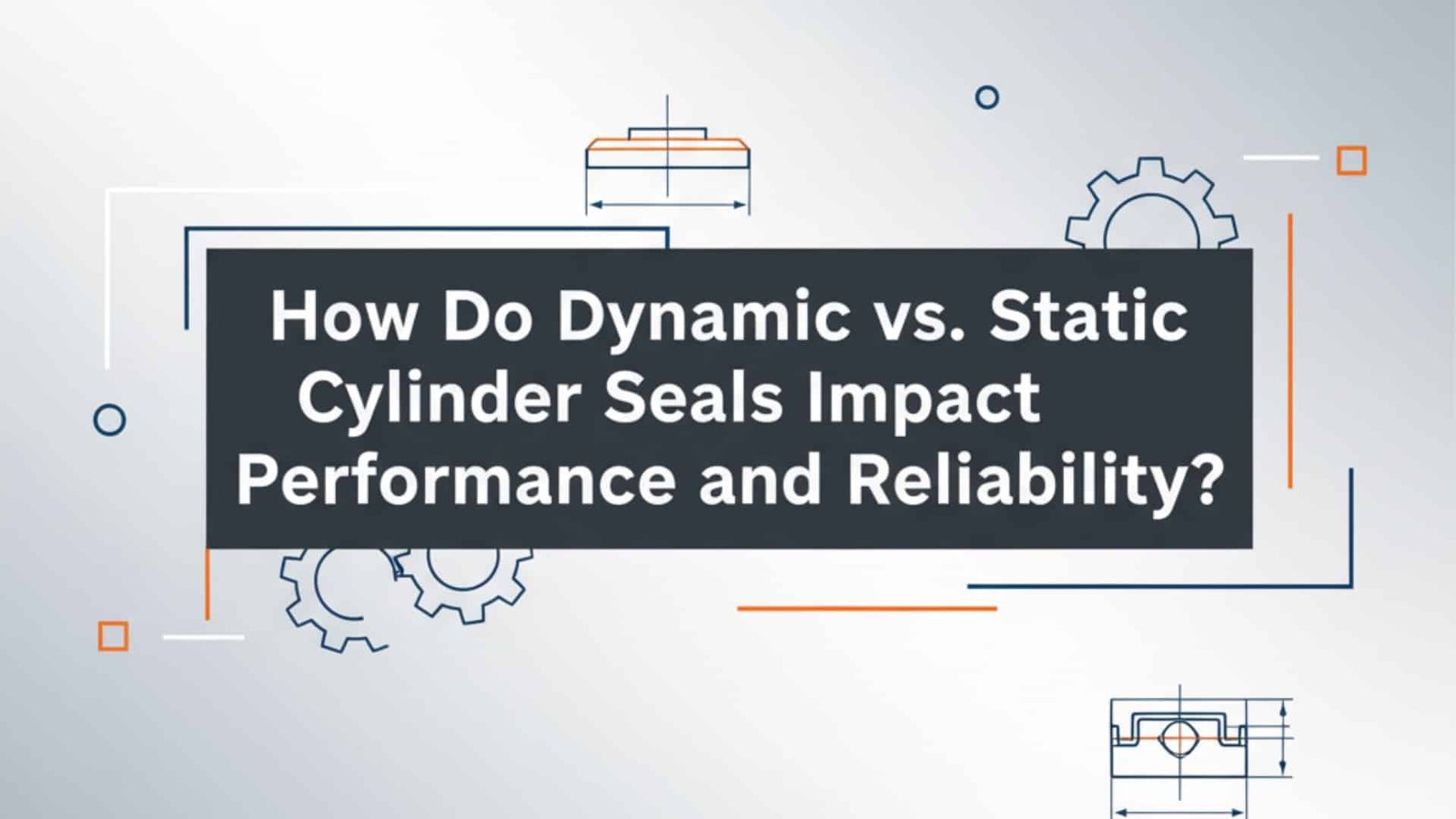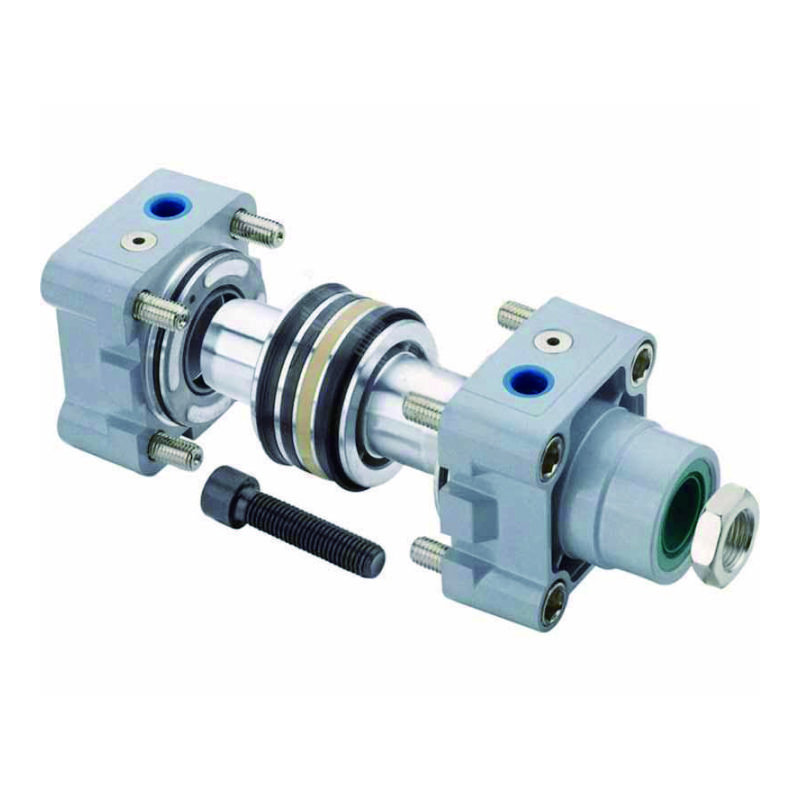
Improper seal selection causes 60% of pneumatic cylinder failures, with dynamic and static seal confusion leading to premature wear, leakage, and costly system downtime averaging $15,000 per incident in manufacturing environments. Dynamic seals handle moving components with specialized materials and designs for friction control, while static seals create stationary pressure barriers using different compounds optimized for compression set resistance1 and long-term sealing performance. Just yesterday, I helped Sarah, a maintenance engineer from Michigan, whose production line was experiencing daily seal failures because she was using static O-rings in dynamic rod applications, causing $8,000 weekly in lost production. 🔧
Innholdsfortegnelse
- What Are the Key Differences Between Dynamic and Static Cylinder Seals?
- Which Seal Types Work Best for Specific Cylinder Applications?
- How Do Bepto Seal Solutions Optimize Performance and Longevity?
What Are the Key Differences Between Dynamic and Static Cylinder Seals?
Understanding seal classifications and their specific design requirements is essential for proper pneumatic system performance and reliability.
Dynamic seals accommodate relative motion between surfaces with specialized materials and geometries that minimize friction while maintaining sealing integrity, whereas static seals create permanent barriers between stationary components using materials optimized for compression resistance and long-term stability.

Dynamic Seal Characteristics
Motion Requirements:
- Accommodate linear or rotary movement
- Minimize friction to reduce wear and energy loss
- Maintain sealing contact under varying pressures
- Handle velocity changes and directional reversals
Designfunksjoner:
- Specialized lip geometries for wiping action
- Low-friction materials and surface treatments
- Controlled interference fits for optimal contact
- Integrated backup rings for high-pressure applications
Material Properties:
- Utmerket abrasion resistance2
- Low coefficient of friction
- Dimensional stability under load
- Chemical compatibility with system fluids
Static Seal Characteristics
Krav til forsegling:
- Create permanent barrier between stationary surfaces
- Resist compression set over extended periods
- Maintain sealing force under thermal cycling
- Accommodate assembly tolerances and surface irregularities
Design Optimization:
- Simple geometries for reliable sealing
- High compression ratios for positive sealing
- Stress distribution for even contact pressure
- Standardized sizes for easy replacement
Sammenligning av ytelse
| Tetningstype | Primær funksjon | Friksjonsnivå | Levetid | Typiske bruksområder |
|---|---|---|---|---|
| Dynamisk | Moving seal | Low to moderate | 1-5 million cycles | Rod seals, piston seals |
| Static | Stationary barrier | Minimal | 10+ år | Port seals, flange gaskets |
Vanlige feilmodi
Dynamic Seal Failures:
- Abrasive wear from contamination
- Extrusion under high pressure
- Thermal degradation from friction heating
- Chemical attack from incompatible fluids
Static Seal Failures:
- Compression set from long-term loading
- Thermal cycling damage
- Chemical degradation
- Installation damage during assembly
Sarah’s situation perfectly illustrates the importance of proper seal selection. Her maintenance team was replacing expensive rod seals with standard O-rings to save money, not realizing that static seals can’t handle the wiping action required for rod applications. The O-rings were failing within hours due to excessive friction and wear. We provided proper dynamic rod seals that have been running trouble-free for 6 months, eliminating her daily maintenance headaches! 💡
Which Seal Types Work Best for Specific Cylinder Applications?
Different cylinder locations and operating conditions require specific seal types and materials for optimal performance and reliability.
Rod seals require dynamic designs with wiping lips and low-friction materials, piston seals need bidirectional capability with pressure-activated sealing, while static seals in ports and flanges use compression-resistant materials optimized for long-term barrier performance.
Rod Seal Applications
Primary Functions:
- Prevent internal pressure leakage
- Exclude external contamination
- Minimize friction for smooth operation
- Provide long service life under cycling
Recommended Seal Types:
- Single-lip wipers for light-duty applications
- Double-lip seals for contaminated environments
- U-cup seals for high-pressure service
- Composite seals for extreme conditions
Piston Seal Applications
Performance Requirements:
- Tetningsevne i begge retninger
- Pressure-activated sealing force
- Low breakaway friction
- Accommodation of side loading
Optimal Seal Configurations:
- O-ring with backup rings for standard service
- U-cup seals for high-pressure applications
- Composite seals for long-life requirements
- Custom profiles for special conditions
Applikasjonsspesifikk utvalgsveiledning
| Søknad | Tetningsplassering | Recommended Type | Valg av materiale | Forventet levetid |
|---|---|---|---|---|
| Standard pneumatisk | Rod | Single-lip wiper | Polyuretan | 2M cycles |
| High-pressure hydraulic | Stempel | U-cup + backup | PTFE composite | 5M sykluser |
| Matforedling | All dynamic | FDA compliant | EPDM/Silicone | 1M sykluser |
| Høy temperatur | All locations | Heat resistant | Viton/FFKM | 3M cycles |
Miljøhensyn
Temperaturpåvirkning:
- Low temperatures require flexible materials
- High temperatures demand thermal stability
- Thermal cycling needs expansion compatibility
- Heat generation from friction must be managed
Kjemisk kompatibilitet:
- Hydraulic fluids require specific elastomers
- Aggressive chemicals need PTFE or FFKM
- Food applications require FDA-approved materials
- Cleaning chemicals affect material selection
Forurensningsfaktorer:
- Abrasive particles require hardened seals
- Moisture ingress needs effective wipers
- Chemical contamination affects material choice
- Filtration level influences seal design
Mark, a hydraulic system designer from Texas, was experiencing inconsistent cylinder performance due to mixed seal applications. His high-pressure system was using standard pneumatic seals that couldn’t handle 3000 PSI operating pressure. We analyzed his application and provided proper high-pressure composite seals with backup rings, eliminating leakage and extending service intervals from weekly to annual maintenance. His system now operates at peak efficiency with 99.9% reliability! 🎯
How Do Bepto Seal Solutions Optimize Performance and Longevity?
Our advanced seal technology and application expertise deliver superior performance, extended service life, and reduced total cost of ownership compared to standard sealing solutions.
Bepto seal solutions combine premium materials, precision manufacturing, comprehensive testing, and application-specific engineering that ensures optimal sealing performance while minimizing friction, wear, and maintenance requirements for maximum system reliability and efficiency.
Avansert materialteknologi
Premium Elastomers:
- High-performance polyurethanes for dynamic applications
- Specialized PTFE compounds for extreme conditions
- Custom material formulations for specific environments
- Enhanced additives for improved performance
Manufacturing Excellence:
- Precision molding for consistent dimensions
- Advanced surface treatments for reduced friction
- Quality control testing on every batch
- Traceability documentation for critical applications
Funksjoner for ytelsesoptimalisering
Dynamic Seal Enhancements:
- Optimized lip geometries for minimal friction
- Integrated wiping elements for contamination exclusion
- Pressure-balanced designs for consistent sealing
- Anti-extrusion features for high-pressure service
Static Seal Improvements:
- Enhanced compression set resistance
- Improved chemical compatibility
- Better thermal stability
- Standardized sizing for easy replacement
Comparative Performance Data
| Prestasjonsmåling | Standard Seals | Bepto Seals | Forbedring |
|---|---|---|---|
| Levetid | 1 million cycles | 3-5 millioner sykluser | 300-400% |
| Friksjonskoeffisient | 0.15-0.25 | 0.08-0.12 | 50% reduksjon |
| Lekkasjerate | 5-10 cc/min | <1 cc/min | 90% forbedring |
| Temperaturområde | -20°F til 200°F | -40°F to 300°F | Utvidet rekkevidde |
Application Engineering Services
Custom Seal Design:
- Application analysis and requirements definition
- Material selection for specific conditions
- Custom geometries for unique applications
- Performance validation and testing
Teknisk støtte:
- Installation training and procedures
- Feilsøking og feilanalyse
- Preventive maintenance recommendations
- Ytelsesovervåking og optimalisering
Program for kvalitetssikring
Testprotokoller:
- Trykktesting til 4 ganger arbeidstrykket
- Friction testing under actual conditions
- Accelerated aging for long-term performance
- Verifisering av kjemisk kompatibilitet
Certification Standards:
- ISO 9001 quality management
- FDA compliance for food applications
- API specifications for oil and gas
- Custom certifications for specific industries
Value Proposition
Total Cost Benefits:
- 40% longer service life reduces replacement frequency
- 50% lower friction reduces energy consumption
- 90% fewer leakage incidents minimize downtime
- Comprehensive warranty coverage provides peace of mind
Our seal technology has delivered exceptional results across diverse applications: 95% reduction in seal-related failures, 60% extension in service intervals, and 45% reduction in total sealing costs. We provide complete sealing solutions, not just components, ensuring your pneumatic systems operate at peak performance with minimal maintenance requirements. 🛡️
Konklusjon
Proper selection and application of dynamic and static cylinder seals is critical for pneumatic system performance, reliability, and cost-effectiveness.
FAQs About Dynamic vs. Static Cylinder Seals
Q: Can I use static O-rings as temporary replacements for dynamic rod seals?
No, static O-rings lack the specialized geometry and materials needed for dynamic applications. They will fail quickly due to excessive friction and wear, potentially causing more expensive damage to cylinder components and creating safety hazards.
Q: How do I determine if my application needs dynamic or static seals?
Dynamic seals are required wherever there is relative motion between sealed surfaces (rods, pistons). Static seals are used for stationary connections (ports, flanges, end caps). If components move relative to each other, dynamic seals are essential.
Q: What factors affect seal life in dynamic applications?
Key factors include operating pressure, cycle frequency, temperature range, contamination levels, fluid compatibility, and installation quality. Proper seal selection considering all these factors can extend life from thousands to millions of cycles.
Q: How often should cylinder seals be replaced in preventive maintenance?
Dynamic seals should be replaced based on cycle count (typically 1-5 million cycles) or performance degradation, while static seals can often last the cylinder’s lifetime unless exposed to extreme conditions. Monitor for leakage and performance changes rather than arbitrary time intervals.
Q: What makes Bepto seals superior to standard aftermarket options?
Bepto seals offer 300-400% longer service life, 50% lower friction, 90% better leakage performance, and extended temperature ranges compared to standard seals, backed by comprehensive application engineering and 3-year warranties versus typical 90-day coverage.



